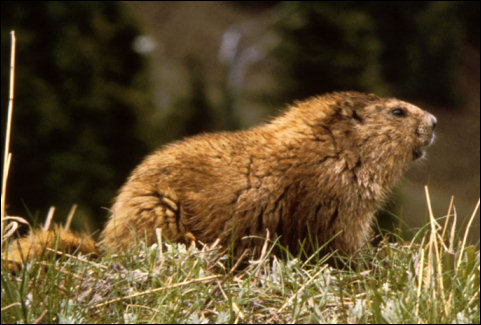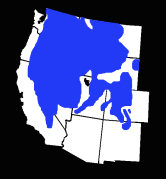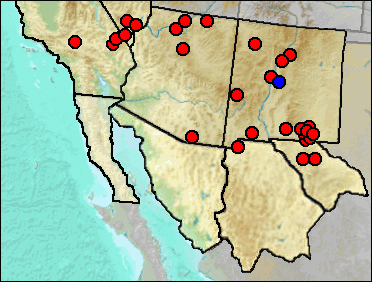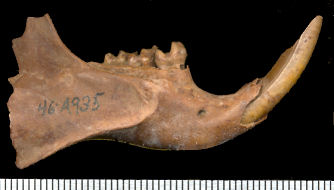Class Mammalia
Order Rodentia
Family Sciuridae
 Although several species of marmot occur
in North America, only Marmota flaviventris (Yellow-bellied Marmot) currently
occurs in our region, and it is the only species reported from the Pleistocene of the
area. Absence of the eastern species, Marmota monax (Woodchuck), suggests that
the Great Plains and incompatible habitat to the south were barriers to marmot
movement.
Although several species of marmot occur
in North America, only Marmota flaviventris (Yellow-bellied Marmot) currently
occurs in our region, and it is the only species reported from the Pleistocene of the
area. Absence of the eastern species, Marmota monax (Woodchuck), suggests that
the Great Plains and incompatible habitat to the south were barriers to marmot
movement.
Fig. 1. Marmota sp. (probably M. monax, the Woodchuck). Photograph by James C. Leupold, courtesy of the US Fish & Wildlife Service.
The current distribution in our region is limited to northern New Mexico (Fig. 2).
 Much of the
population occurs in the high northern mountain ranges. Stearns (1942) and Murray
(1957) used the then-accepted ecology of the marmot as indicating near-timberline
conditions at New La Bajada Hill and the Guadalupe Mountains, respectively. Harris
(1963) observed marmots at 5980 ft at Sambrito Creek, a tributary of the San Juan
River, and attributed their presence at this low elevation to irrigation that supported
green fodder during the spring drought period when green fodder is unlikely to occur
naturally. He later (1970b) hypothesized that presence in the Pleistocene south of its
present range likely was due to increased winter precipitation; that approximately 2
inches of December-February precipitation plus some minimal spring precipitation would
be sufficient to support the green fodder required by Marmota through what now
is the severe spring drought characteristic of New Mexico. This, however, ignored the effects of lower summer temperatures that may have been sufficient with little or no additional winter precipitation.
Much of the
population occurs in the high northern mountain ranges. Stearns (1942) and Murray
(1957) used the then-accepted ecology of the marmot as indicating near-timberline
conditions at New La Bajada Hill and the Guadalupe Mountains, respectively. Harris
(1963) observed marmots at 5980 ft at Sambrito Creek, a tributary of the San Juan
River, and attributed their presence at this low elevation to irrigation that supported
green fodder during the spring drought period when green fodder is unlikely to occur
naturally. He later (1970b) hypothesized that presence in the Pleistocene south of its
present range likely was due to increased winter precipitation; that approximately 2
inches of December-February precipitation plus some minimal spring precipitation would
be sufficient to support the green fodder required by Marmota through what now
is the severe spring drought characteristic of New Mexico. This, however, ignored the effects of lower summer temperatures that may have been sufficient with little or no additional winter precipitation.
Fig. 2. Approximate current geographic range of the Yellow-bellied Marmot. Adapted from Frase and Hoffmann (1980).
Present absence of Marmota in the southern high ranges that are mesic enough to presumably support marmots suggests that some time between the late Wisconsin and historic times, drought was sufficient to eradicate them throughout the southern reaches of the region.
Presence of marmot and Bushy-tailed Woodrat at Pratt Cave in McKittrick Canyon has been suggested as indicating Holocene survival in a Guadalupe Mountains refugium. Lundelius (1979:243) noted that "McKittrick Canyon is much more mesic than the surrounding area." He goes on to say, "It seems likely that this has been the case of all of post-Pleistocene time and perhaps earlier. Conditions in the canyon remained favorable for the maintenance of both Marmota flaviventris and Neotoma cinerea after they had disappeared in the surrounding area." Harris (1990a) suggested that shallow, late Pleistocene deposits were mixed with late-Holocene materials at Pratt Cave and that these are Pleistocene occurrences. Neither alternative can be demonstrated to be the case at this time.
Likely marmots are over-represented in published faunal lists because of their ease of identification.
Literature. Frase and Hoffmann 1980; Harris 1963, 1970b, 1990a; Lundelius 1979; Murray 1957; Schultz and Howard 1935; Stearns 1942.

 Several of the earlier
published records were in the form of Marmota sp. or Marmota cf.
flaviventris. Since considerable study has revealed no other species within our
timeframe and region, these have been recorded here as Marmota flaviventris.
Several of the earlier
published records were in the form of Marmota sp. or Marmota cf.
flaviventris. Since considerable study has revealed no other species within our
timeframe and region, these have been recorded here as Marmota flaviventris.
Fig. 1. Right dentary of Marmota flaviventris from Isleta Cave No. 1. Scale in mm.
Sites.
Pleistocene: Cave in Manzano Mts. (Howell 1915).
Rancholabrean: Cylinder Cave (Mead et al. 2005); Keet Seel Lange 1956); Mescal Cave (Jefferson 1991b: cf.); Tooth Cave (Mead et al. 2005; Tule Springs (Springer et al. 2005).
Rancholabrean/?Early Holocene: Mitchell Caverns (Jefferson 1991b: ?).
Wisconsin: New La Bajada Hill (Stearns 1942); North Papago Cave (Mead et al. 2005).
Mid Wisconsin: Devil Peak (Reynolds, Reynolds, and Bell 1991); Papago Springs Cave (Czaplewski and Mead et al. 1999; Skinner 1942); Pendejo Cave (Harris 2003); U-Bar Cave (Harris 1987).
Mid/Late Wisconsin: Dark Canyon Cave (Tebedge 1988); Kaetan Cave (Mead et al. 2005); Rampart Cave (Wilson 1942); Sierra Diablo Cave (UTEP); Vulture Cave (Mead and Phillips 1981).
Late Wisconsin: Animal Fair 18-20 ka (Harris 1989); Antelope Cave (Reynolds, Reynolds, Bell, and Pitzer 1991); Big Manhole Cave (Harris 1993c); Dust Cave (Harris and Hearst 2012); Government Cave (Lange 1956); Harris' Pocket (Harris 1970a); Hermit's Cave (Harris 1993c); Lower Sloth Cave (Logan 1983); Marmot Cave (Thompson and Morgan 2001); Mercury Ridge (Jefferson et al. 2015); Muskox Cave (Logan 1981); Mystery Light Cave (this volume); Pendejo Cave (Harris 2003); Sandia Cave (Thompson and Morgan 2001); Sheep Camp Shelter (Gillespie 1985); Tse'an Olje (Mead et al. 2005); Tularosa Cave (Howell 1915); U-Bar Cave 14-15 ka (Harris 2003); Upper Sloth Cave (Logan and Black 1979).
Late Wisconsin/Holocene: Balcony Room (Harris 1993c); Baldy Peak Cave (Harris 1993c); Burnet Cave (Schultz and Howard 1935); Fowlkes Cave (Dalquest and Stangl 1984b); Isleta Cave No. 2 (Harris 1993c); Kokoweef Cave (Reynolds, Reynolds, et al. 1991); Newberry Cave (Jefferson 1991b); Pratt Cave (Lundelius 1979); Tooth Cave (Mead et al. 2005).
Literature. Czaplewski and Mead et al. 1999; Dalquest and Stangl 1984b; Gillespie 1985; Harris 1970a, 1987, 1989, 1993c, 2003; Harris and Hearst 2012; Howell 1915; Jefferson 1991b; Logan 1981, 1983; Logan and Black 1979; Lundelius 1979; Mead and Phillips 1981; Mead et al. 2005; Reynolds, Reynolds, and Bell 1991; Reynolds, Reynolds, et al. 1991; Reynolds, Reynolds, Bell, and Pitzer 1991; Schultz and Howard 1935; Skinner 1942; Springer et al. 2005; Stearns 1942; Thompson and Morgan 2001; Tebedge 1988; Wilson 1942.
Last Update: 6 Apr 2015